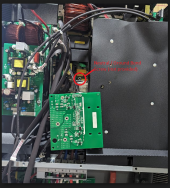I installed a single EG4 6000ex inverter along with a rack of EG4 batteries in my garage building.
I'm hoping to get some feedback/comments about these issues.
1. We found that the subpanel in the garage had neutral and ground bars/connections bonded together even though there were 4-wires coming from the main panel (where neutral/ground was also bonded) about 250ft away. We separated the ground and neutral bars/connections before going into EG4 AC input. The EG4 AC output goes to a new subpanel where neutral and ground bars/connections are NOT bonded. We moved some breakers from the old grid-powered subpanel to the new EG4-powered subpanel, one of them is a GFCI breaker. Things seem to be working in the garage. However, in another building which has its own subpanel (again, the neutral and ground bars/connections are bonded along with a grounding rod), a few of the GFCI breakers tripped without using them. Could this be caused by us separating neutral/ground bars in the garage building's subpanel? or is this related to EG4 inverter somehow?
2. Some of the lights in the building NOT powered by the EG4 flickers intermittently. This hasn't happened before. Could this be caused by the EG4 installation somehow? maybe also related to the neutral/ground bars/connections being bonded?
Thank you!
Update: I found that the GFCIs in another subpanel trips when the EG4 is is running on Utility power, but they won't if EG4 is on battery mode. I've also corrected that subpanel's bonding by separating out the grounds to see if this corrects the tripping issue.
Update2: correcting the subpanels bonding still did NOT fix the GFCI breakers/outlets tripping issue.
I'm hoping to get some feedback/comments about these issues.
1. We found that the subpanel in the garage had neutral and ground bars/connections bonded together even though there were 4-wires coming from the main panel (where neutral/ground was also bonded) about 250ft away. We separated the ground and neutral bars/connections before going into EG4 AC input. The EG4 AC output goes to a new subpanel where neutral and ground bars/connections are NOT bonded. We moved some breakers from the old grid-powered subpanel to the new EG4-powered subpanel, one of them is a GFCI breaker. Things seem to be working in the garage. However, in another building which has its own subpanel (again, the neutral and ground bars/connections are bonded along with a grounding rod), a few of the GFCI breakers tripped without using them. Could this be caused by us separating neutral/ground bars in the garage building's subpanel? or is this related to EG4 inverter somehow?
2. Some of the lights in the building NOT powered by the EG4 flickers intermittently. This hasn't happened before. Could this be caused by the EG4 installation somehow? maybe also related to the neutral/ground bars/connections being bonded?
Thank you!
Update: I found that the GFCIs in another subpanel trips when the EG4 is is running on Utility power, but they won't if EG4 is on battery mode. I've also corrected that subpanel's bonding by separating out the grounds to see if this corrects the tripping issue.
Update2: correcting the subpanels bonding still did NOT fix the GFCI breakers/outlets tripping issue.
Last edited:



